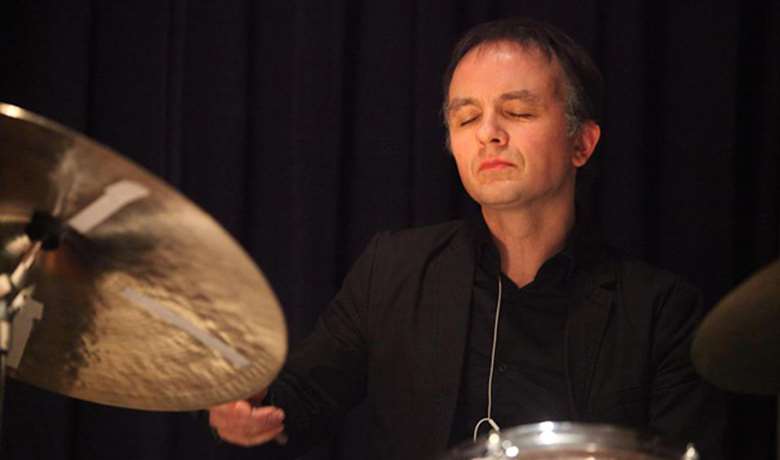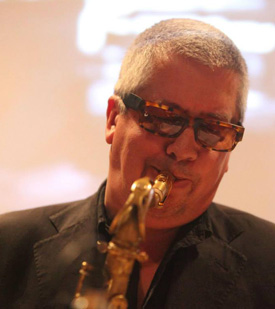Dylan Howe's Subterranean waltzes at Watermill Jazz
Monday, February 9, 2015
With enough rave reviews of his album Subterranean: New Designs on Bowie's Berlin to earn it a rightful place in all the end of year jazz polls, 2014 certainly ended on a high for drummer Dylan Howe.

As well as all the applause for the album (which interprets, for a small jazz group, music from David Bowie's Low and Heroes albums from 1977) an equally potent live show also thrilled the critics, bringing together an all-star band – Ross Stanley on piano, Dave Whitford on double bass, Steve Lodder on synthesizers and Andy Sheppard on saxophones – that would effortlessly re-capture the multi-layered mix of cold, ambient textures, and hard-hitting bop, the album offered up.
 For those that missed out, extra demand has kept Howe's Bowie show on the road, and tonight, assembled in a darkened hall in front of a huge projection screen screening grainy footage of 1970's Berlin, the band began with a surprise add-on to previous shows, and a beautiful reading of recent Bowie song 'Where Are You Now' Its queasy synth melody, in unison with tenor sax, was met with dark, discordant piano chords, creating a tense, eerie ambience that would sustain throughout, thus acquainting all in the hall with the underlying mood of the album, of which, all would be rolled out in sequence tonight.
For those that missed out, extra demand has kept Howe's Bowie show on the road, and tonight, assembled in a darkened hall in front of a huge projection screen screening grainy footage of 1970's Berlin, the band began with a surprise add-on to previous shows, and a beautiful reading of recent Bowie song 'Where Are You Now' Its queasy synth melody, in unison with tenor sax, was met with dark, discordant piano chords, creating a tense, eerie ambience that would sustain throughout, thus acquainting all in the hall with the underlying mood of the album, of which, all would be rolled out in sequence tonight.
Following a sax-led 'Subterraneans', cyclic percussion parts from Bowie's original 'Weeping Wall' had been lifted from Low to layer a new, dramatic waltz take on the tune. It was here that the band shifted gear, proving that, whilst Howe's arrangements have gone to enormous lengths to preserve the bleak beauty of Bowie's recordings, what brought colour, energy, and great contrast to all the wired atmospherics was the injection of raw swing.
'All Saints' best exampled this. From Whitford's solo bass intro, to its main theme trailing off into a long, ruthless swing-out, it resembled the roadmap to Coltrane's 'Resolution', right down to Sheppard's Trane-like tone snaking around the melody, or the screamy intensity he reached at breakneck tempo. Stanley's solo here would also dance uptight, but while a Casio-sounding synth break from Lodder added extra thrill, it indirectly shattered the illusion of '60s small group, delivering something more suited to sci-fi.
 Throughout the show, the passion in the performance against the glare of the visuals was entrancing. If not back to a drizzly, post-war Berlin, the band's soft soundtrack to old clips of airports, art galleries and the Autobahn during drowsy ballad 'Some Are' took you somewhere else, anywhere but a small jazz club in darkest Dorking, that at any moment will be flicking on its lights to announce a short interval and the winners of the raffle. It was mesmerising.
Throughout the show, the passion in the performance against the glare of the visuals was entrancing. If not back to a drizzly, post-war Berlin, the band's soft soundtrack to old clips of airports, art galleries and the Autobahn during drowsy ballad 'Some Are' took you somewhere else, anywhere but a small jazz club in darkest Dorking, that at any moment will be flicking on its lights to announce a short interval and the winners of the raffle. It was mesmerising.
Elsewhere, a moody 'Art Decade' was unveiled with a short drum solo, as Howe's sluggish, military-style rolls, and tribal tom fills rattled into an ethereal mix of laser strings, and Morse Code-like bleeps. 'Warszawa' would resonate as shadowy at first, before its lazy pulse and sombre melody were abruptly flipped into a higher register by a crack of snare, signalling some more killer swinging from all.
As the set was coming to a close, and the film behind the band bleached out to white to match the noise seeping through a long ovation for 'Warszawa', Howe smiled. His group would go on to deliver the last two tracks of his five star album, and he would once more go out on a high, and this writer will plead that if you're yet to see this sublime show and believe that jazz covers of rock standards are standard these days, you should hear how Howe interprets this one.
– Mark Youll
– Photos by Jon Frost